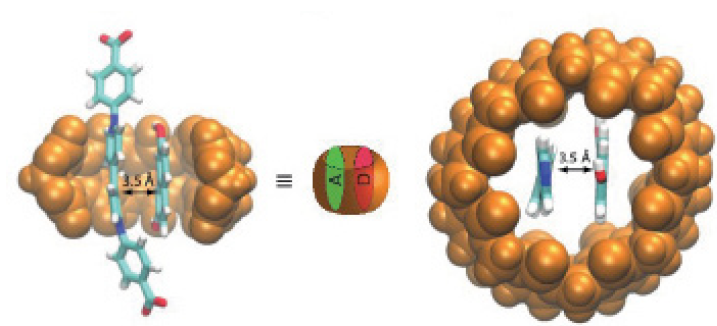Orbital energies in supramolecular donoracceptor complexes & data digitalization

What have biological organisms capable of photosynthesis and organic solar cells in common? They are based on photoelectron transfer processes or charge transfer: Moving charges between different energy levels even determines the color of many materials and molecular mixtures. Describing these processes accurately is still very challenging. Especially, when we look at realistic systems from chemistry or biology. There, we always have a combination of at least two molecular species, called donor and acceptor. If we also have a host as in a larger molecule encasing the donor-acceptor contact, we speak of a supramolecular complex.
With the YIN Grant, we aim to establish a systematic approach to determine the energy level offset relevant for charge transfer processes in such supramolecular complexes. An important aspect of the project is also to provide the data in a publicly accessible repository following the FAIR principles.
Frank Biedermann’s group has expertise in the chemical synthesis of macro-cyclic systems and dyes which form functional supramolecular complexes. They are used e.g. for optical sensing applications in water or biofluids. The group has also developed the open-access repository SupraBank.org which allows to deposit supramolecular interaction parameters, including those needed to describe self-assembled donor-acceptor complexes of interest in this project.
Julia Maibach in turn is an expert in photoelectron spectroscopy characterization for energy materials. With this powerful surface science technique, it is possible to obtain both qualitative and quantitative composition information of surfaces and interfaces. Using UV light for excitation, even electronic information such as the position of the relevant donor levels for charge transfer processes can be determined.
We started with a defined supramolecular system based on cucurbit uril as host with indole and methyl viologen dichloride as donor and acceptor. At first, we characterized the individual components and in a next step the mixtures of host, donor, and acceptor. Different approaches to fabricate thin films were investigated until homogeneously coated surfaces were preparable. However, due to poor electronic conductivity of the obtained thin films for the analyses, we ran into experimental problems which could not be solved during the duration of the YIN grant. Regardless of this obstacle, we are undeterred bridging the gap between (organo)chemical and physical data and both groups will continue working together.
Moreover, we have identified key parameters that are essential to be stored for X-ray and UV photoelectron spectroscopy and introduced the option to report them into the SupraBank interface. Finally, the option to bundle data packages on SupraBank has been implemented.

